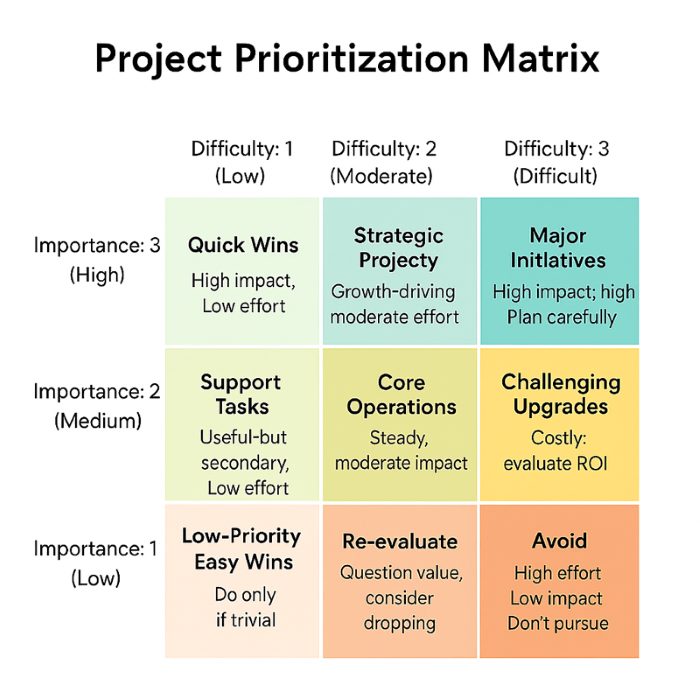By Evan Hackel
When every initiative feels urgent, leaders of fast-growing franchise systems need a clear way to choose what really matters. This simple tool helps franchisors balance bold growth moves with the realities of effort and capital.
Drowning in Ideas
The leadership team at a midsize franchisor was stuck.
Their system was expanding quickly. New franchisees wanted more training and support. Marketing leaders were pitching digital campaigns to build brand awareness. Operations wanted a new technology platform. Development was pushing site expansion.
Every idea had merit. Every initiative seemed urgent. Yet the franchisor’s executives knew one truth that defines growth:
You can’t do everything
Time, people, and capital are finite. The hardest decision isn’t what to pursue, but what not to pursue.
They didn’t need more ideas. They needed a way to cut through the noise, to decide with confidence which initiatives deserved attention and which should wait—or never be done at all.
That’s where the nine-box decision-making grid comes in.
What the Nine-Box Grid Is
The nine-box decision-making grid is a deceptively simple tool for prioritizing competing projects. It evaluates initiatives across two dimensions:
- Importance – How critical is this initiative to the franchise system’s strategy, growth, or survival?
- Difficulty – How challenging will it be to implement, factoring in both effort and capital required?
Each project is rated on a 1–3 scale for both importance and difficulty. Those scores place it into one of nine boxes on the grid:
- High Importance / Low Difficulty (3–1) → Quick wins.
- Low Importance / High Difficulty (1–3) → Easy “no-go” decisions.
- Middle boxes → More nuanced choices requiring sequencing, piloting, or rethinking.
By turning subjective debates into a structured evaluation, the nine-box helps franchisors focus resources on the initiatives that truly move the system forward.
The Project Prioritization Matrix

The illustration shows a nine-box framework, The Nine-Box Decision-Making Grid, which includes practical labels franchisors can use in planning.
The Nine-Box Decision-Making Grid plots initiatives by Importance (vertical) and Difficulty, or effort plus capital (horizontal). Each box guides franchisors toward “Quick Wins,” “Strategic Projects,” or clear “Avoid” decisions.
The clarity of the nine-box grid lies in its action-oriented outcomes:
- Quick Wins (high importance, low difficulty) → Roll out immediately. These energize franchisees and achieve fast progress.
- Strategic Projects (high importance, moderate difficulty) → Plan carefully. Often these are marketing upgrades, training programs, or technology platforms that drive long-term system value.
- Major Initiatives (high importance, high difficulty) → Expansion moves, acquisitions, or brand overhauls. Pursue selectively with full buy-in and capital.
- Support Tasks (moderate importance, low difficulty) → Useful enhancements but not mission critical.
- Core Operations (moderate importance, moderate difficulty) → Standard processes that keep the franchise running but don’t drive growth.
- Challenging Upgrades (moderate importance, high difficulty) → Examples include costly site remodels. Consider ROI carefully.
- Low-Priority Easy Wins (low importance, low difficulty) → Do only if you have unused resources that are not being used to achieve more important tasks.
- Re-Evaluate (low importance, moderate difficulty) → Many times, they are time traps; validate that they are worth the effort.
- Avoid (low importance, high difficulty) → High-cost distractions. Clear no-go.
Instead of getting stuck in endless debate, franchisor leaders can point to the matrix and ask: Is this a quick win or a costly distraction?
Best Practices for Franchisors
The nine-box tool is powerful, but like any framework, its value depends on how it’s applied. Consider these best practices:
- Make it a system-wide conversation. Involve leaders from marketing, operations, training, and development to reduce blind spots.
- Be honest about difficulty. Difficulty equals both effort and capital. Underestimating cost or franchisee workload can doom projects.
- Revisit regularly. As your franchise system grows, conditions change. What was once a “Major Initiative” may later become a “Strategic Project” or even a “Quick Win.”
- Link decisions to action. Every box should point to next steps: fund it, plan it, pilot it, or kill it.
The Ingaged Leadership Edge
The nine-box grid is most effective when applied through Ingaged Leadership, a philosophy centered on involvement, authentic listening, and curiosity. Some of its hallmarks include:
- Involvement. Invite franchisees – through advisory councils or pilot groups – to help rate initiatives. They see frontline realities franchisors may miss.
- Authentic Listening. Franchisees want to feel heard. Even if their ideas land in “Re-evaluate” or “Avoid,” sincere listening builds trust.
- Curiosity. Leaders who ask, “Why did you rate it that way?” uncover insights about customer trends, operational challenges, or hidden costs.
By combining the grid with Ingaged Leadership, franchisors turn decision-making into a tool for both prioritization and relationship-building. The process itself reinforces trust, alignment, and shared ownership.
“Difficulty isn’t just about effort — it’s also about capital. Ignore that, and you’ll overload your system with impossible projects.”
Why Fast-Growing Franchisors Benefit Most
For large corporations, the nine-box grid is one of many planning tools. For fast-growing franchisors, it can be transformative, because:
- Scarce resources demand focus. The grid ensures limited staff time and franchisee capital are spent on what matters most.
- It tempers entrepreneurial energy. Growth-minded franchisors often chase every new idea. The grid forces sober evaluation.
- It builds transparency. Franchisees see that priorities are chosen through clear criteria, not guesswork. That boosts trust and alignment.
From Overload to Clarity
Back in the franchisor’s boardroom, the whiteboard no longer feels overwhelming. By rating each initiative on importance and difficulty, leaders and franchisees can quickly see where to focus. Some projects become immediate quick wins. Others, while exciting, are revealed as high-effort, low-impact distractions—and are dropped.
The result? A franchise system no longer paralyzed by too many options, but energized by clarity.
That’s the promise of the nine-box decision-making grid: a framework that helps franchisors stop drowning in possibilities and start executing on what matters most.

About Evan Hackel
As an author, keynote speaker, consultant, and entrepreneur, Evan Hackel has been instrumental in launching more than 20 businesses and has managed a portfolio of brands with systemwide sales of more than $5 billion. He is the creator of Ingaged Leadership, the author of the book Ingaging Leadership: The Ultimate Edition, and a thought leader in leadership and success.
Evan is the CEO of Ingage Consulting. Visit www.evanhackel.com


